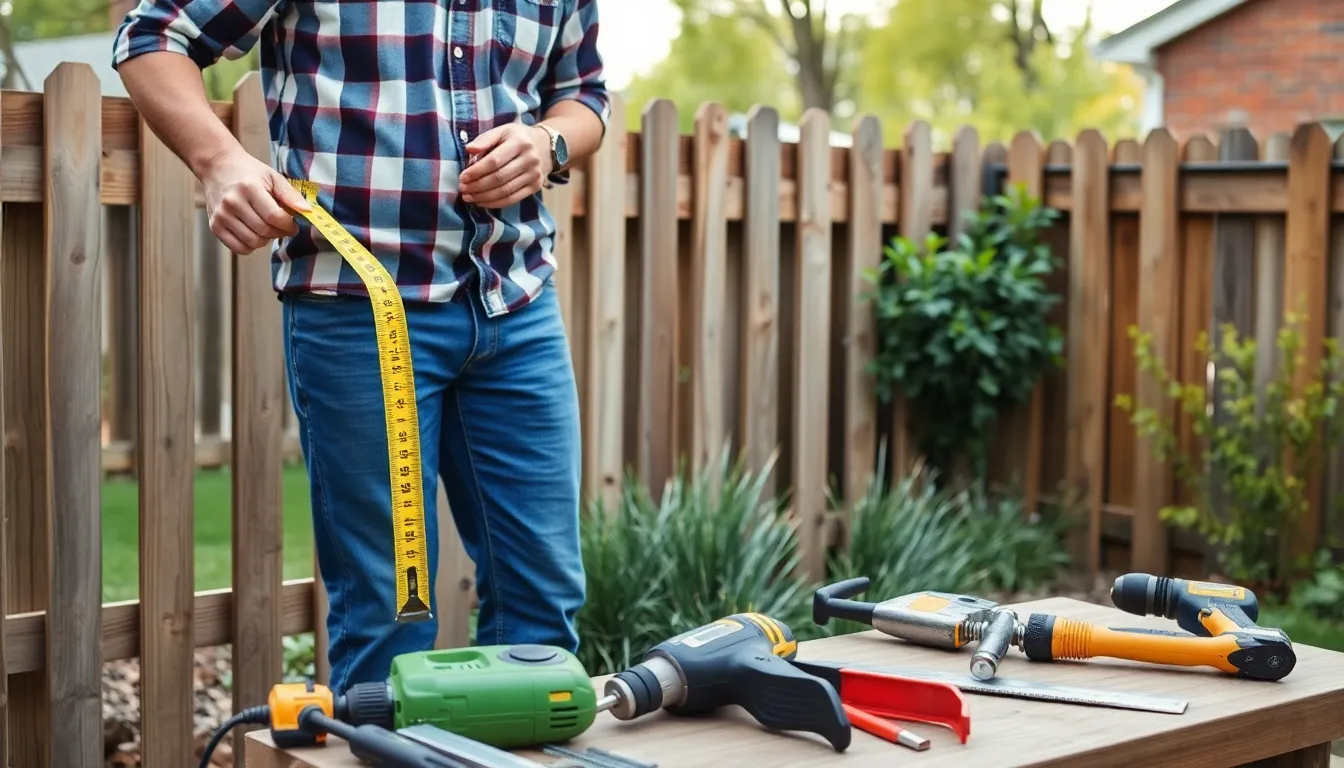Building a fence might not sound as thrilling as skydiving or bungee jumping, but trust us—DIY fence picket projects can be a wild ride! Picture this: transforming your backyard into a stylish sanctuary while channeling your inner carpenter. With just a few tools and a sprinkle of creativity, they can turn mundane pickets into eye-catching masterpieces that’ll have neighbors peeking over their own fences in envy.
Table of Contents
ToggleDIY Fence Picket Projects Overview
DIY fence picket projects offer a range of possibilities for homeowners. Choosing the right design can elevate outdoor spaces, providing both functionality and aesthetic appeal. Various styles exist, including traditional vertical pickets, decorative patterns, or even unique shapes that showcase personal creativity.
Common materials for these projects include wood, vinyl, or composite materials. Wood remains popular due to its natural look and flexibility in design. More homeowners opt for vinyl for its durability and low maintenance. Composite materials combine durability with wood-like aesthetics.
Designing a picket fence requires planning and precision. Taking accurate measurements ensures the structure will fit properly in the desired location. Creating a visual mock-up can help in visualizing the final product. Different color choices further enhance personalization, allowing for matching or contrasting with existing outdoor elements.
Simple tools are essential for these projects. Essential tools include a saw, drill, level, and measuring tape. Using these tools correctly ensures sturdy and well-aligned pickets. Enlisting the help of friends or family members can make the process quicker and more enjoyable.
DIY fence projects offer an opportunity for creativity and skill development. Experience in carpentry helps, though beginners can successfully complete projects with careful instruction. Online tutorials and comprehensive guides provide necessary support throughout the process. Engaging in DIY projects often fosters a sense of accomplishment and satisfaction once completed.
Preparing for Your Project

Preparation plays a crucial role in DIY fence picket projects. Understanding the essential tools and materials ensures a smooth building experience.
Tools and Materials Needed
Selecting the correct tools simplifies the building process. Basic tools include a saw, drill, measuring tape, and level. For materials, choose quality pickets that match the desired style. Commonly used materials consist of wood, vinyl, and composite. Each has unique benefits, like wood providing a classic look, vinyl offering low maintenance, and composite ensuring durability. Additionally, gather supplies such as screws, brackets, and wood stains, which contribute to the fence’s final appearance.
Choosing the Right Pickets
Choosing the right pickets influences both functionality and aesthetics. Consider the style that complements the home and landscape. Styles range from traditional vertical pickets to modern horizontal designs. It’s essential to select an appropriate height for privacy needs. Some homeowners prefer shorter pickets for visibility, while others prioritize privacy with taller options. Assess material durability based on local weather conditions. Ultimately, selecting the right pickets ensures a blend of beauty and practicality in the final fence design.
Popular DIY Fence Picket Ideas
DIY fence picket projects offer a range of creative options. Homeowners can explore ideas that enhance both style and functionality.
Decorative Fence Designs
Decorative fence designs elevate curb appeal. Creative patterns, such as pointed, scalloped, or arched pickets, add personality to outdoor spaces. They provide an opportunity to incorporate colors or finishes that complement home exteriors. For example, a painted picket fence in soft pastels creates a charming garden element, while stained wood lends a traditional touch. Adding elements like lattice or trellis structures can introduce vertical interest and support climbing plants.
Functional Fence Solutions
Functional fence solutions serve practical purposes along with aesthetic benefits. Privacy fences made with closely spaced pickets offer security while minimizing visibility from the outside. Additionally, a fence with a built-in gate enhances accessibility to gardens or yards, improving functionality. Stockade-style pickets, tall and solid, deter intruders and create private retreats. Consider reinforcing fence posts for stability against harsh weather. Choosing durable materials ensures longevity in any backyard setting.
Steps to Building Your Fence Picket Project
Building a fence picket project involves several structured steps that lead to a finished product, enhancing outdoor spaces.
Measuring and Planning
Accurate measurements set a solid foundation for the project. Begin by determining the fence location and layout, ensuring clearance from obstacles. Mark the corners and ends with stakes or markers, establishing a clear outline. Measure the pickets’ height based on design preferences, considering local zoning regulations. Visual planning aids creativity; sketching the design or using software helps conceptualize the finished look. Review the measurements repeatedly to prevent errors, ensuring every cut and installation aligns perfectly.
Assembling the Pickets
Gathering materials comes next, including pickets, rails, nails, and brackets. Begin assembly by laying out the rails horizontally on a flat surface, securing them with brackets if needed. Align the pickets vertically, spacing them evenly for aesthetics and stability. Fasten each picket into place using nails or screws, starting from one end and working towards the other. Ensure that pickets are plumb and straight, adjusting as necessary with a level. Regularly check alignment during assembly, which maintains the fence’s overall look and function.
Adding Finishing Touches
Finishing touches elevate the fence’s appearance and enhance durability. Start with sanding rough edges on the pickets to prevent splinters. Apply a protective finish or paint that matches the home exterior, ensuring longevity against weather elements. Consider sealing wooden pickets with water-resistant coatings for added protection. Install gate hardware if included in the design, ensuring smooth operation. Finally, thoroughly inspect the entire fence, making any necessary adjustments to ensure a polished, professional look.
Maintenance Tips for Your Fence
Keep the fence looking new by regularly cleaning it. Use a pressure washer or a simple hose to remove dirt and debris. Choose a gentle soap solution for wood to avoid damage, while vinyl can tolerate stronger cleaners.
Inspect the fence annually for signs of wear. Look for cracks, rot, or rust depending on the material. Addressing issues promptly prevents major repairs in the future.
Seal wooden pickets every two to three years to protect against water damage. A quality sealant extends the lifespan of the wood, making it resistant to moisture and pests.
Repaint or restain the fence as needed. More frequent application maintains its appearance, particularly for older wooden fences. Consider using weather-resistant paint or stain for added durability.
Maintain landscaping around the fence to prevent overgrowth. Trim bushes and grass that could come into contact with the pickets. Keeping vegetation clear promotes air circulation and minimizes moisture buildup.
Check the fence posts for stability. If they feel loose, reposition or reinforce them to ensure support. Strong posts are crucial for the overall integrity of the fence.
Consider applying insect repellents for wooden pickets. Pests can compromise the structure over time. Look for eco-friendly options that do not harm surrounding plants or wildlife.
Store materials safely if doing repairs or upgrades. Keeping tools and leftover materials organized prevents accidents and maintains accessibility. Proper storage also extends the life of tools.
Routine maintenance turns DIY fence picket projects into lasting investments. Plan a maintenance schedule that fits the climate conditions in your area. Adhering to these tips ensures the fence remains a beautiful and functional addition to the home.
DIY fence picket projects offer an excellent opportunity for homeowners to express creativity while enhancing their outdoor spaces. With the right tools and materials anyone can create a stunning fence that combines style and functionality.
Whether opting for traditional designs or more decorative patterns the possibilities are endless. Engaging in these projects not only results in a beautiful addition to a home but also provides a rewarding experience.
By following proper planning and maintenance tips homeowners can ensure their DIY fences remain attractive and durable for years to come. Embracing this hands-on approach can truly transform a backyard into a personal oasis.

